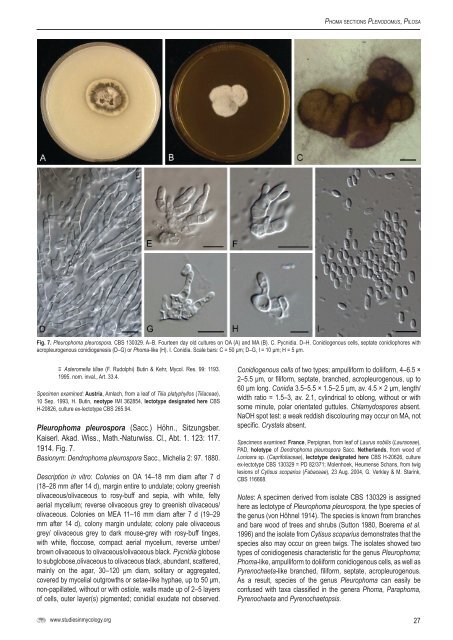redisposition of Phoma-like anamorphs in Pleosporales - CBS - KNAW
redisposition of Phoma-like anamorphs in Pleosporales - CBS - KNAW
redisposition of Phoma-like anamorphs in Pleosporales - CBS - KNAW
Create successful ePaper yourself
Turn your PDF publications into a flip-book with our unique Google optimized e-Paper software.
<strong>Phoma</strong> sections Plenodomus, Pilosa<br />
Fig. 7. Pleurophoma pleurospora. <strong>CBS</strong> 130329. A–B. Fourteen day old cultures on OA (A) and MA (B). C. Pycnidia. D–H. Conidiogenous cells, septate conidiophores with<br />
acropleurogenous conidiogenesis (D–G) or <strong>Phoma</strong>-<strong>like</strong> (H). I. Conidia. Scale bars: C = 50 μm; D–G, I = 10 μm; H = 5 μm.<br />
≡ Asteromella tiliae (F. Rudolphi) But<strong>in</strong> & Kehr, Mycol. Res. 99: 1193.<br />
1995. nom. <strong>in</strong>val., Art. 33.4.<br />
Specimen exam<strong>in</strong>ed: Austria, Amlach, from a leaf <strong>of</strong> Tilia platyphyllos (Tiliaceae),<br />
10 Sep. 1993, H. But<strong>in</strong>, neotype IMI 362854, lectotype designated here <strong>CBS</strong><br />
H-20826, culture ex-lectotype <strong>CBS</strong> 265.94.<br />
Pleurophoma pleurospora (Sacc.) Höhn., Sitzungsber.<br />
Kaiserl. Akad. Wiss., Math.-Naturwiss. Cl., Abt. 1. 123: 117.<br />
1914. Fig. 7.<br />
Basionym: Dendrophoma pleurospora Sacc., Michelia 2: 97. 1880.<br />
Description <strong>in</strong> vitro: Colonies on OA 14–18 mm diam after 7 d<br />
(18–28 mm after 14 d), marg<strong>in</strong> entire to undulate; colony greenish<br />
olivaceous/olivaceous to rosy-buff and sepia, with white, felty<br />
aerial mycelium; reverse olivaceous grey to greenish olivaceous/<br />
olivaceous. Colonies on MEA 11–16 mm diam after 7 d (19–29<br />
mm after 14 d), colony marg<strong>in</strong> undulate; colony pale olivaceous<br />
grey/ olivaceous grey to dark mouse-grey with rosy-buff t<strong>in</strong>ges,<br />
with white, floccose, compact aerial mycelium, reverse umber/<br />
brown olivaceous to olivaceous/olivaceous black. Pycnidia globose<br />
to subglobose,olivaceous to olivaceous black, abundant, scattered,<br />
ma<strong>in</strong>ly on the agar, 30–120 μm diam, solitary or aggregated,<br />
covered by mycelial outgrowths or setae-<strong>like</strong> hyphae, up to 50 μm,<br />
non-papillated, without or with ostiole, walls made up <strong>of</strong> 2–5 layers<br />
<strong>of</strong> cells, outer layer(s) pigmented; conidial exudate not observed.<br />
Conidiogenous cells <strong>of</strong> two types; ampulliform to doliiform, 4–6.5 ×<br />
2–5.5 μm, or filiform, septate, branched, acropleurogenous, up to<br />
60 μm long. Conidia 3.5–5.5 × 1.5–2.5 μm, av. 4.5 × 2 μm, length/<br />
width ratio = 1.5–3, av. 2.1, cyl<strong>in</strong>drical to oblong, without or with<br />
some m<strong>in</strong>ute, polar orientated guttules. Chlamydospores absent.<br />
NaOH spot test: a weak reddish discolour<strong>in</strong>g may occur on MA, not<br />
specific. Crystals absent.<br />
Specimens exam<strong>in</strong>ed: France, Perpignan, from leaf <strong>of</strong> Laurus nobilis (Lauraceae),<br />
PAD, holotype <strong>of</strong> Dendrophoma pleurospora Sacc. Netherlands, from wood <strong>of</strong><br />
Lonicera sp. (Caprifoliaceae), lectotype designated here <strong>CBS</strong> H-20626, culture<br />
ex-lectotype <strong>CBS</strong> 130329 = PD 82/371; Molenhoek, Heumense Schans, from twig<br />
lesions <strong>of</strong> Cytisus scoparius (Fabaceae), 23 Aug. 2004, G. Verkley & M. Star<strong>in</strong>k,<br />
<strong>CBS</strong> 116668.<br />
Notes: A specimen derived from isolate <strong>CBS</strong> 130329 is assigned<br />
here as lectotype <strong>of</strong> Pleurophoma pleurospora, the type species <strong>of</strong><br />
the genus (von Höhnel 1914). The species is known from branches<br />
and bare wood <strong>of</strong> trees and shrubs (Sutton 1980, Boerema et al.<br />
1996) and the isolate from Cytisus scoparius demonstrates that the<br />
species also may occur on green twigs. The isolates showed two<br />
types <strong>of</strong> conidiogenesis characteristic for the genus Pleurophoma;<br />
<strong>Phoma</strong>-<strong>like</strong>, ampulliform to doliiform conidiogenous cells, as well as<br />
Pyrenochaeta-<strong>like</strong> branched, filiform, septate, acropleurogenous.<br />
As a result, species <strong>of</strong> the genus Pleurophoma can easily be<br />
confused with taxa classified <strong>in</strong> the genera <strong>Phoma</strong>, Paraphoma,<br />
Pyrenochaeta and Pyrenochaetopsis.<br />
www.studies<strong>in</strong>mycology.org<br />
27

















